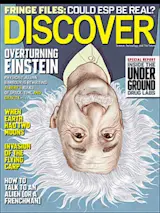MUSEUM
Rio Tinto Center Natural History Museum of Utah
After spending decades stuffed into a Depression-era library, the Natural History Museum of Utah has a new home: an expansive, copper-clad building in Salt Lake City designed to evoke the many layers of the state’s famously complex rock formations:
Overlooking the Salt Lake Valley, the museum incorporates the landscape of the surrounding Wasatch Mountains into its exhibits. Great Salt Lake, a gallery focused on local ecosystems and geology, features a glorious panoramic view of the lake itself.
In a series of interactive exhibits, visitors can explore the area’s history by manipulating the natural forces that shape the local topography, gleaning clues to early human cultures from a re-created archaeological dig, and learning words from the languages of Utah’s five native tribes. Open now.—Mary Beth Griggs
BOOKS
by Rachel HerzPsychologist Rachel Herz’s charmingly revolting new book examines repugnance in all ...














